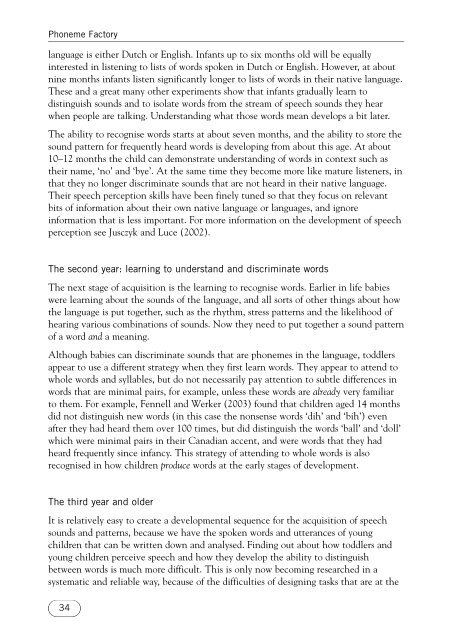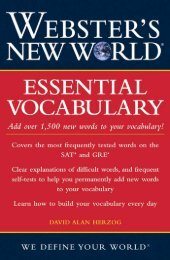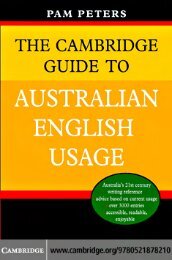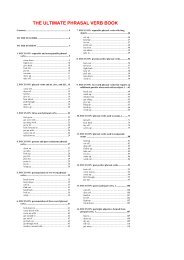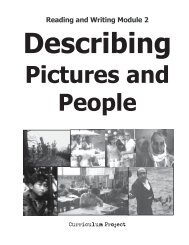Developing Speech and Language Skills - Noel's ESL eBook Library
Developing Speech and Language Skills - Noel's ESL eBook Library
Developing Speech and Language Skills - Noel's ESL eBook Library
Create successful ePaper yourself
Turn your PDF publications into a flip-book with our unique Google optimized e-Paper software.
Phoneme Factorylanguage is either Dutch or English. Infants up to six months old will be equallyinterested in listening to lists of words spoken in Dutch or English. However, at aboutnine months infants listen significantly longer to lists of words in their native language.These <strong>and</strong> a great many other experiments show that infants gradually learn todistinguish sounds <strong>and</strong> to isolate words from the stream of speech sounds they hearwhen people are talking. Underst<strong>and</strong>ing what those words mean develops a bit later.The ability to recognise words starts at about seven months, <strong>and</strong> the ability to store thesound pattern for frequently heard words is developing from about this age. At about10–12 months the child can demonstrate underst<strong>and</strong>ing of words in context such astheir name, ‘no’ <strong>and</strong> ‘bye’. At the same time they become more like mature listeners, inthat they no longer discriminate sounds that are not heard in their native language.Their speech perception skills have been finely tuned so that they focus on relevantbits of information about their own native language or languages, <strong>and</strong> ignoreinformation that is less important. For more information on the development of speechperception see Jusczyk <strong>and</strong> Luce (2002).The second year: learning to underst<strong>and</strong> <strong>and</strong> discriminate wordsThe next stage of acquisition is the learning to recognise words. Earlier in life babieswere learning about the sounds of the language, <strong>and</strong> all sorts of other things about howthe language is put together, such as the rhythm, stress patterns <strong>and</strong> the likelihood ofhearing various combinations of sounds. Now they need to put together a sound patternof a word <strong>and</strong> a meaning.Although babies can discriminate sounds that are phonemes in the language, toddlersappear to use a different strategy when they first learn words. They appear to attend towhole words <strong>and</strong> syllables, but do not necessarily pay attention to subtle differences inwords that are minimal pairs, for example, unless these words are already very familiarto them. For example, Fennell <strong>and</strong> Werker (2003) found that children aged 14 monthsdid not distinguish new words (in this case the nonsense words ‘dih’ <strong>and</strong> ‘bih’) evenafter they had heard them over 100 times, but did distinguish the words ‘ball’ <strong>and</strong> ‘doll’which were minimal pairs in their Canadian accent, <strong>and</strong> were words that they hadheard frequently since infancy. This strategy of attending to whole words is alsorecognised in how children produce words at the early stages of development.The third year <strong>and</strong> olderIt is relatively easy to create a developmental sequence for the acquisition of speechsounds <strong>and</strong> patterns, because we have the spoken words <strong>and</strong> utterances of youngchildren that can be written down <strong>and</strong> analysed. Finding out about how toddlers <strong>and</strong>young children perceive speech <strong>and</strong> how they develop the ability to distinguishbetween words is much more difficult. This is only now becoming researched in asystematic <strong>and</strong> reliable way, because of the difficulties of designing tasks that are at the34


